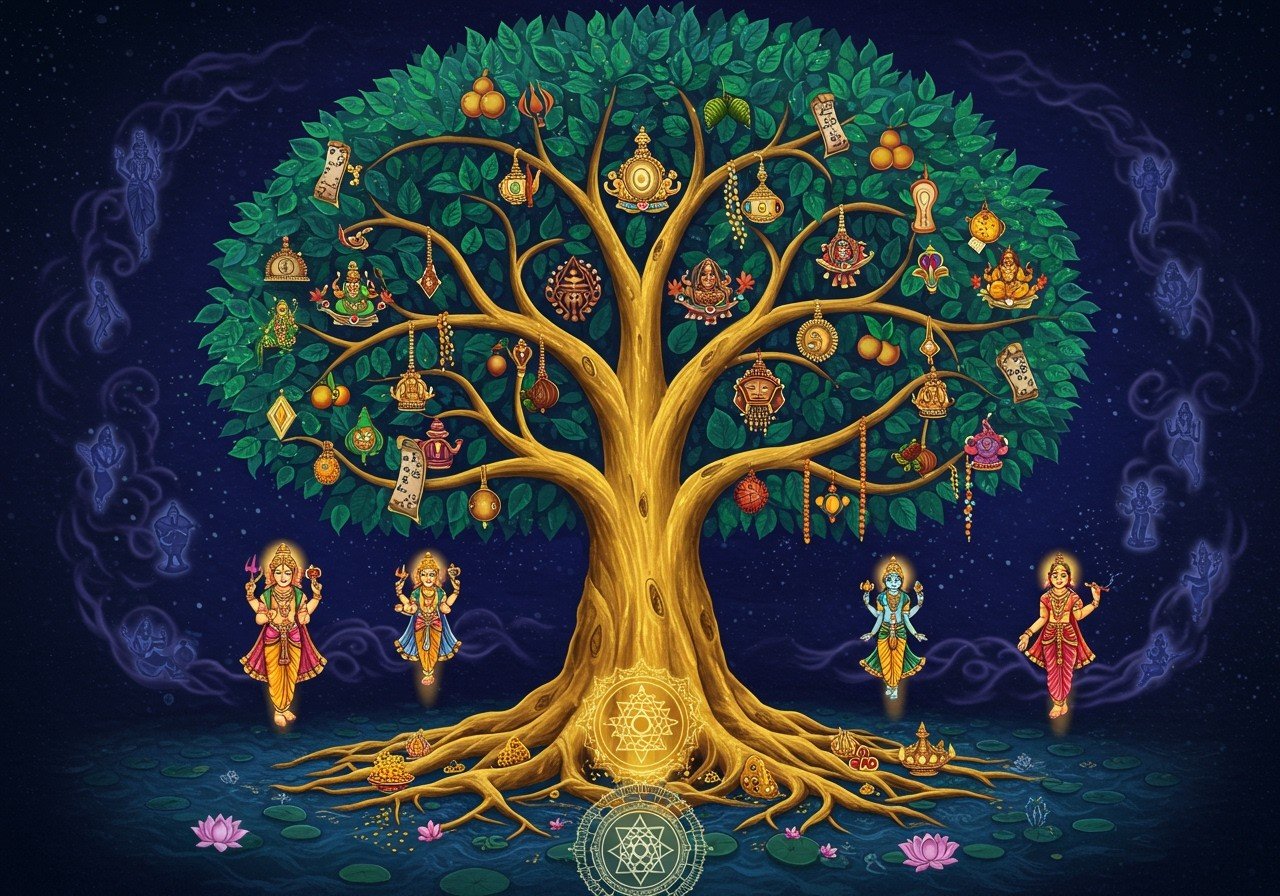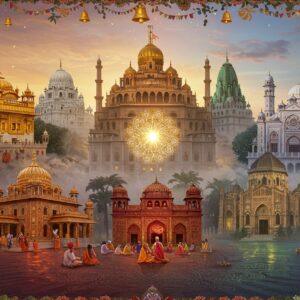
The Kalpavriksha, also called Kalpataru or Kalpadruma, isn’t just a tree in Indian mythology; it’s a potent symbol woven into the fabric of Hindu, Buddhist, and Jain traditions. This divine tree, known for granting wishes, holds a special place in the hearts of those who value tradition and ritualistic practices. Join us as we explore the rich mythology, symbolism, and enduring significance of the Kalpavriksha, and discover how it continues to resonate in our modern world.
Ancient Tales and Celestial Origins
The stories surrounding the Kalpavriksha are as captivating as they are varied. Legend says it arose during the Samudra Manthan, the epic churning of the cosmic ocean, alongside other divine treasures. In Hindu epics like the Mahabharata and Ramayana, the Kalpavriksha is a wish-granting marvel, a testament to divine power. Buddhist scriptures embrace it as a symbol of enlightenment and prosperity, while Jain interpretations emphasize non-violence and respect for nature. These diverse narratives speak to the Kalpavriksha’s universal appeal across different spiritual paths.
A Symbol of Abundance and Eternal Life
The Kalpavriksha, often depicted with lush foliage and bountiful fruits, embodies deep meanings within Indian culture. It represents abundance, prosperity, and the promise of eternal life, making it a powerful symbol of divine blessings.
- In Hinduism, the Kalpavriksha embodies wish fulfillment and divine generosity, often associated with celestial origins and the power of mantras. Vaishnavism, a branch of Hinduism, even reveres these trees as divine beings residing in Goloka, the celestial abode of Krishna, where they fulfill every desire.
- Buddhism links the Kalpavriksha to the potential for enlightenment and spiritual growth. It symbolizes the inherent ability of Bodhisattvas, enlightened beings, to guide others on their spiritual journeys.
- In Jainism, Kalpa-Vrikshas represent the fulfillment of desires within realms of pleasure. They serve as metaphors for contentment and the enjoyment of worldly pleasures, reminding us of the importance of balance.
Often referred to as the “World Tree,” the Kalpavriksha connects to a broader concept of a central, life-giving tree found in various mythologies. This reinforces its symbolism as a source of eternal life and divine grace.
The Kalpavriksha in the Natural World
The symbolism of the Kalpavriksha extends to real-life trees, especially those considered sacred in India, like the Banyan (Ficus benghalensis) and Peepal (Ficus religiosa). These majestic trees are not only ecologically vital, supporting biodiversity and providing shelter for countless creatures, but also hold deep cultural significance. Their medicinal properties have been recognized for centuries, playing an important role in traditional healing practices. People often tie threads around their trunks or offer prayers beneath their branches as a mark of reverence and respect. Conservation efforts to protect these sacred groves are crucial for preserving India’s natural heritage and ensuring that future generations can continue to benefit from these ecological and spiritual treasures.
Kalpavriksha in Modern Times
The enduring symbolism of the Kalpavriksha continues to inspire contemporary art, literature, and even environmental movements. Its representation of abundance and sustainability resonates deeply in a world grappling with ecological challenges. Even in the commercial realm, brands often use Kalpavriksha imagery to evoke a sense of ethical and organic practices. Digital platforms have made it easier than ever to access Kalpavriksha-inspired products and practices, bringing the convenience of tradition into our modern lives.
Spiritual and Philosophical Significance
On a spiritual level, the Kalpavriksha represents ultimate knowledge and wisdom. It can serve as a focus for meditation, helping to cultivate inner peace and fulfillment. Philosophically, it symbolizes human potential and the journey of self-discovery. Learn more about sacred symbols.
The tree is also connected to the chakra system, particularly the crown chakra, which represents enlightenment and higher consciousness. Spiritual leaders often invoke the Kalpavriksha as a source of divine inspiration, reminding us of our connection to the sacred.
How Poojn Helps You Connect with Sacred Tree Traditions
At poojn.in, we understand the deep significance of honoring sacred trees like the Kalpavriksha. We offer a wide selection of authentic puja items and materials to help you connect with these traditions:
- Pure copper and brass planters ideal for sacred saplings. We understand the importance of using the right materials for nurturing these special plants.
- Traditional incense and dhoop to create a sacred atmosphere during tree worship ceremonies. Their fragrant smoke carries your prayers and intentions skyward.
- Natural cotton wicks (battis) for aarti, the ceremonial offering of light. The gentle flicker of the flame symbolizes the divine presence.
- Pure ghee and oil for deepam offerings, another way to offer light and invoke blessings. The purity of these offerings reflects the purity of your devotion.
- Copper and brass aarti thalis for tree puja, providing a beautiful and respectful way to perform the ritual. The intricate designs add to the sacredness of the ceremony. Buy cotton threads here.
- Sacred threads and moli for tying around trees, a symbolic gesture of connection and respect. The vibrant colors of the threads represent different aspects of divinity.
- Pure sandalwood powder and kumkum for applying tilak, the mark of blessing. The fragrance of sandalwood and the vibrant red of kumkum add to the auspiciousness of the ceremony.
All our products meet the highest standards of purity and authenticity required for sacred rituals. You can easily order these items through our website poojn.in or contact us on WhatsApp at 9476142738 for personalized guidance on products for tree worship.
For questions about specific puja items or bulk orders for temple or community ceremonies, call us at 03369029784. We deliver across India with careful packaging to ensure the sanctity of all ritual items.
As India’s largest Dashakarma bhandar, we understand the importance of using the correct materials for sacred ceremonies. Our expert team can guide you in selecting the right items based on your specific ritual needs, blending traditional values with the convenience of modern online shopping.
Embracing the Timeless Wisdom of Kalpavriksha
The Kalpavriksha remains a cherished symbol in Indian culture, reminding us of the abundance and blessings in our lives. Its timeless wisdom encourages us to seek harmony with nature and embrace our potential for growth. In our fast-paced modern world, the Kalpavriksha stands as a gentle reminder of the values that ground us, bridging the past with the present and offering wisdom in every leaf and root. Let this sacred tree inspire you to seek balance, embrace sustainability, and celebrate our diverse heritage.
Common Questions about the Kalpavriksha
What exactly is the Kalpavriksha? It’s a wish-fulfilling divine tree in Hindu mythology, believed to grant any desire to those who pray with sincere devotion.
Read more about sacred plants here.
Which tree is considered the Kalpavriksha? The banyan tree is often identified with the Kalpavriksha due to its longevity, strength, and spiritual significance in Indian culture. Other trees, like the coconut tree, are also sometimes associated with the Kalpavriksha because of their many uses.
What does Kalpavriksha mean? The name itself means “tree of life” or “wish-fulfilling tree,” symbolizing abundance, prosperity, and the fulfillment of desires. It embodies the potential for both material and spiritual well-being.
Why is the Kalpavriksha important in Hindu mythology? It’s believed to have emerged during the churning of the cosmic ocean (Samudra Manthan) and is considered a divine gift. Explore Yantras and Yagyas.
Where can I find a Kalpavriksha? Banyan and other sacred trees are found throughout India, often near temples and holy sites. However, the true Kalpavriksha resides in the realm of mythology and represents a powerful concept rather than a specific location. Discover Chhattisgarh temples.
How is the Kalpavriksha incorporated into rituals? It serves as a symbol of prosperity and blessings. People often pray around these sacred trees, tie threads, and offer flowers to seek their blessings.
What does the Kalpavriksha represent in Indian culture? It symbolizes eternal life, strength, wisdom, and the interconnectedness of all life. It serves as a reminder of the spiritual path towards enlightenment.
Can I plant a Kalpavriksha at home? While planting a banyan tree is possible, it requires significant space due to its size and extensive root system. It’s often better suited for large gardens or public spaces.


